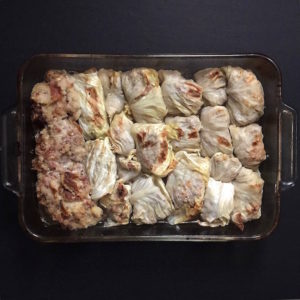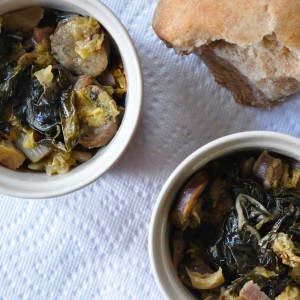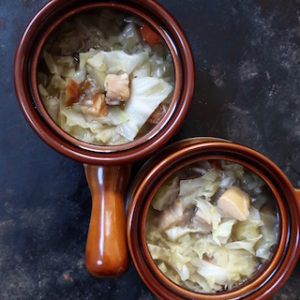Deconstructed Cabbage Cake with Sausage
Just as some people marvel at flour, water, and yeast becoming bread, I never cease to be amazed at the transformation that occurs when cabbage, some sort of pork product, and fat encounter a pot, low heat, and time. This decidedly dour vegetable softens into tenderness, its fumes turn fragrant, and its juices taste almost chickeny. The smallest amount of meat flavors a huge pot. And no matter how much I make, the two of us manage to eat it all up.

This is why, despite our fondness for Jane Grigson’s Cabbage in the Troo Style, I decided to branch out. Mind you, I didn’t stray all that far, nationwise, paging into The Cooking of Southwest France.

Try to contain your astonishment.

Given my fondness for the book, I wondered why I hadn’t tried Wolfert’s cabbage recipe sooner. Last week, as NPR blared (think BBC) I reread the recipe, and was reminded why I’d never tried this particular Paula: cabbage cake with sasuage requires forming the cabbage/sausage mixture into a cake. Once formed, the cabbage cake is parked on the pan lid. The cook then uses her free hand to butter the pan afresh and flips the cake back into the pan. A crisp exterior is thus assured.

In the best of all possible worlds–a mythical place we do not inhabit–the United States Congress would not have voted to impeach yet a second time as I write. Nor would your hostess struggle with collagen disease, forbidding cabbage flips.

To this end, cabbage cake with sausage became deconstructed cabbage cake with sausage. It went into the oven, and emerged delicious.
The trick is double blanching. As Ms. Wolfert says:
Double blanching makes the cabbage lighter and easier to digest.
Don’t whine. Don’t argue. Paula Wolfert is Paula Wolfert for a reason. My husband, who has eaten millions of cabbage dishes, took one bite and asked what I’d done differently. The cabbage was silky tender and hours later, when the ravages of cabbage eating take effect, it was as Ms. Wolfert said: easier to digest.

Wolfert’s recipe calls for a Catalan sausage called Butifarra, made from pork belly, cinnamon, nutmeg, cloves, majoram, and cayenne. She suggests substituting any Toulouse sausage or fresh sausage purchased from a butcher. I am not fond of cinnamon in savory dishes, and lockdown makes shopping challenging anyway. I used an herb sausage made by Fra’Mani, and was pleased with the results.

The recipe called for lard or clarified butter; I used a mixture of butter and olive oil.
My dish was neither crisp nor cake-like, but it was truly delicious, and differs enough from Cabbage in The Troo Style to merit sharing.

Deconstructed Cabbage Cake with Sausage
Adapted from a Paula Wolfert recipe in the Cooking of Southwest France
Preparation time: about 30 minutes hands-on, then 90 minutes-2 hours unattended baking time.
Please read notes before cooking.
Serves: depending on your cabbage, serves 2-4; a 1-pound (about a half-kilo) cabbage fed 2 with leftovers.
1 large cabbage, 1-3 pounds/about 1/2-1 kilo
1 bay leaf, for the blanching water
tablespoon coarse salt, for the blanching water (see notes)
butter and olive oil, for sautéeing
about 4 ounces/114 grams pancetta, cubed
1-2 garlic cloves, peeled and minced (optional; I like garlic)
4 sausage links: about 1 pound/454 grams
black pepper, to taste
salt; taste carefully as the pancetta and sausage will be salty
Red wine vinegar, for sprinkling over finished dish
Instructions
Fill a large pot with water and bring to a boil.
While the water heats, discard any wilted or damaged outer cabbage leaves. Quarter the cabbage, discarding core, or save it for another dish. My cabbage kind of fell apart, so do the best you can.
Once the water reaches rolling boil, lower the cabbage pieces in and cook five minutes. (A spider or similar tool is helpful here.)
Remove cabbage, drain in colander.
If you live in drought territory, toss your cabbage water outside.
Bring a fresh pot of water to boil, adding bay leaf and coarse salt. Add cabbage and cook ten minutes. Drain.
Drain cabbage under cold water. Squeeze dry thoroughly. I did this with clean dishtowels, rolling the cabbage up tightly.
Once the cabbage is dry and cool enough to handle, chop it.
Place a large, ovenproof heavy skillet over medium high heat. Melt about one tablespoon each butter and tablespoon olive oil together. (you may need more, depends on pan size) Lower heat if pancetta begins burning, the fats are burning, or they’re splattering. Add the pancetta and garlic, if using, and cook, stirring, until pancetta is browned, about three minutes. Add the cabbage, stirring to coat. Turn the burner off and set the pan aside.
Now you’re going to steam the sausages. If you have a steamer, great. If not, set a large, deep pan, like a wok, on your largest stove burner. If you have a steamer trivet, use it. If not, juryrig one by opening both ends of a tuna fish can, or by rolling tinfoil into balls large enough to support a bowl. You want a bowl large enough to hold your sausages.
If all of this is too much of a hassle, just make the sausages the regular way. Who will know?
Be sure to prick each sausage with a knife or fork. No matter how you cook them, you don’t want them to explode.
Preheat your oven to 200F/95C.
Allow the sausages to cool enough to handle, then slice into coins.
If any liquid has collected in your sausage steaming bowl, tip that into the cabbage pan.
Add the sausage coins into your pan of cabbage and pancetta, stirring to mix. Taste for salt and pepper. It’s unlikely you’ll need salt. If the pan looks dry, add a bit more butter.
Slide the pan into the oven and bake. This is a good-natured dish and will sit in a low oven from 90 minutes to two hours. If you want to speed things up, increase the oven heat to 300-325F/150-200C and check for doneness after one hour.
Paula Wolftert suggests serving cabbage cake with thinly sliced country rye or whole wheat bread; I had neither, but did have a nice country loaf, which was delicious.
Deconstructed Cabbage Cake will keep, refrigerated, up to five days. Do not freeze it.
Notes:
Wolfert’s recipe called for Savoy cabbage; I had a green one–the plain, smooth sort, so that’s what I used.
As noted in the blog, I did not have access to Butifarra sausage, so bought Fra’Mani Herb Sausage, and was very happy with it.
The original recipe calls for coarse Kosher salt. My kosher salt is fine, so I used Maldon salt, which is coarse. My advice is to use what you have–you’re blanching a cabbage, not finishing a dish.
Again, cabbage has a bad rap–do try this. It’s inexpensive, filling, and truly delicious. Don’t be put off by the double blanching or the brown appearance. This is a dish that defies appearances.
Time and again the United States administration’s behaviors have left me horrified, shocked, and wondering what to say here. This is not a political blog. Then again, saying nothing seems wrong. Longtime readers know I am no fan of the outgoing–I was going to say leadership, but he was no kind of leader.





